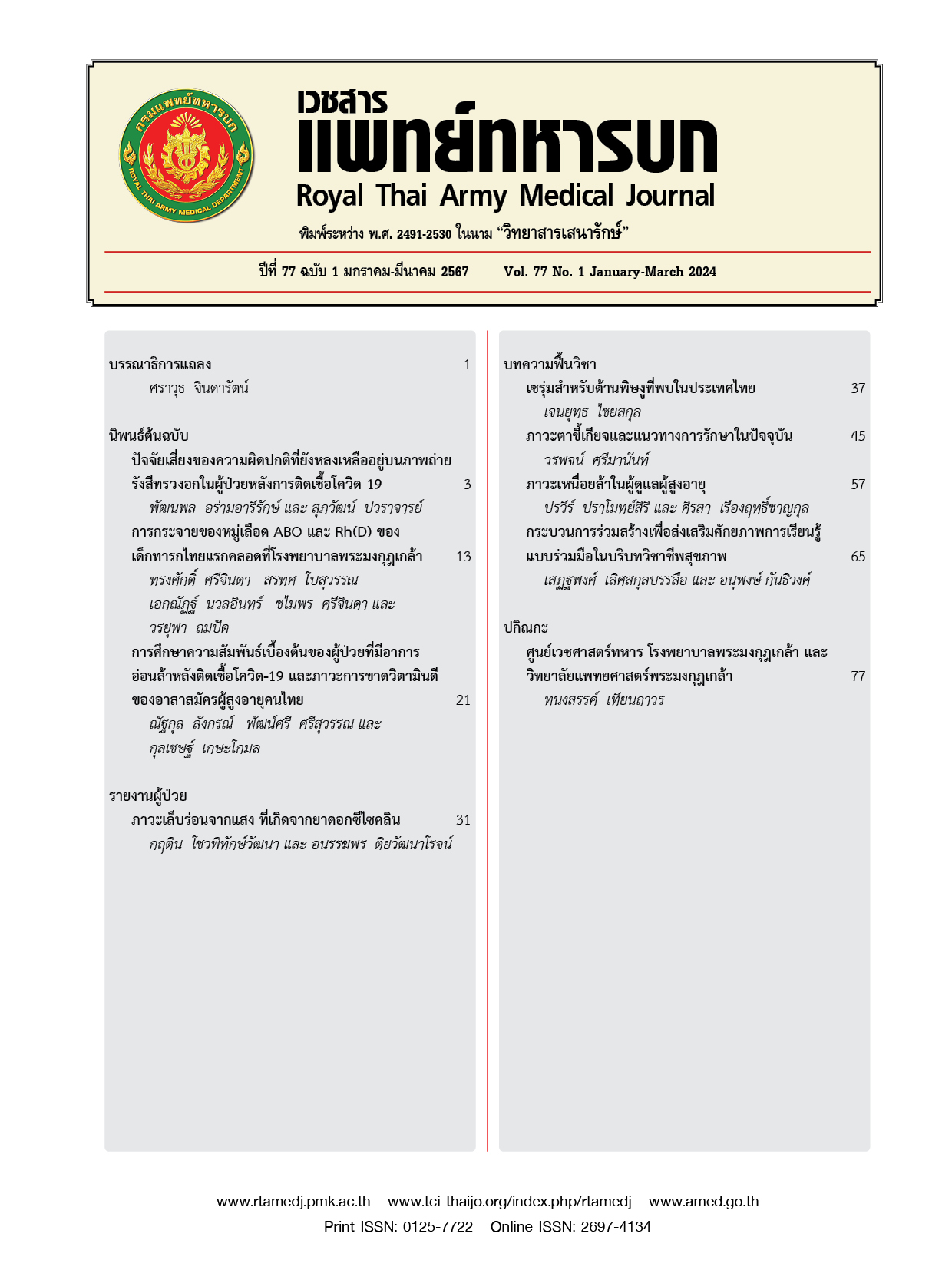การศึกษาความสัมพันธ์เบื้องต้นของผู้ป่วยที่มีอาการอ่อนล้าหลังติดเชื้อโควิด-19 และภาวะการขาดวิตามินดี ของอาสาสมัครผู้สูงอายุคนไทย
Main Article Content
บทคัดย่อ
ที่มาและความสำคัญ จากสถานการณ์การระบาดของโรคโควิด-19 (Coronavirus disease 2019) จนถึงปัจจุบัน พบผู้ติดเชื้อมากกว่า 600 ล้านคน ผู้ป่วยที่หายจากการติดเชื้อสามารถหลงเหลืออาการในระยะยาวได้ ร้อยละ10-20 อาการที่พบบ่อย คือ อาการอ่อนเพลีย ซึ่งส่งผลกระทบต่อชีวิตประจำวัน โดยเฉพาะในผู้สูงอายุ มีการศึกษาพบ ว่าภาวะวิตามินดีต่ำสัมพันธ์กับอาการรุนแรงในผู้ป่วยที่ติดเชื้อโควิด-19 และวิตามินดีมีฤทธิ์สามารถยับยั้งการอักเสบ และช่วยฟื้นฟูอวัยวะหลังจากการติดเชื้อโควิด-19 แต่อย่างไรก็ตามยังไม่พบการศึกษาความสัมพันธ์ของอาการอ่อนล้าหลังติดเชื้อโควิด-19 กับระดับวิตามินดี วัตถุประสงค์ เพื่อศึกษาความสัมพันธ์ของผู้ป่วยที่มีอาการอ่อนล้าหลังติดเชื้อโควิด-19 และภาวะการขาดวิตามินดี วัสดุและวิธีการ เป็นการวิจัยแบบ Analytic observational casecontrol study โดยทำการศึกษาระดับวิตามินดีของอาสาสมัครคนไทยอายุ 60-75 ปี ที่เคยติดเชื้อโควิด-19 และได้รับการรักษาแบบผู้ป่วยนอก ณ ห้องตรวจโรคผู้ป่วยนอก และหน่วยตรวจโรค โรงพยาบาลพระมงกุฎเกล้า อีกทั้งเคยได้รับการเจาะระดับวิตามินดีในเลือด (25(OH) Vitamin D) จำนวน 2 กลุ่ม คือ กลุ่มที่ได้รับการวินิจฉัยภาวะอ่อนล้าหลังติดเชื้อโควิด-19 และกลุ่มที่ไม่มีภาวะดังกล่าว (กลุ่มควบคุม) เก็บรวบรวมข้อมูลในระยะเวลาตั้งแต่เดือน มกราคม พ.ศ. 2566 ถึง ธันวาคม พ.ศ. 2566 ผลการศึกษา ผลจากการวิเคราะห์ข้อมูลพบว่าระดับวิตามินดีในกลุ่มที่มีภาวะอ่อนล้าหลังติดเชื้อโควิด-19 มีค่าต่ำกว่ากลุ่มควบคุมอย่างมีนัยสำคัญ (ค่ามัธยฐาน 28.10 ng/mL เทียบ กับ 41.30 ng/mL, p = 0.0001748, Mann-Whitney U test) การวิเคราะห์สหสัมพันธ์ของ Spearman ไม่พบสหสัมพันธ์ที่มีนัยสำคัญระหว่างระดับวิตามินดีและคะแนนความเหนื่อยล้า VAS score ในกลุ่มที่มีภาวะอ่อนล้า (R = -0.1, p = 0.520) ชี้ให้เห็นว่าไม่มีหลักฐานของความสัมพันธ์ระหว่างตัวแปรทั้งสองนี้ อีกทั้งระดับวิตามินดีในผู้ที่เป็นโรคเบาหวาน โรคหัวใจขาดเลือดและไขมันในเลือดสูง มีแนวโน้มต่ำกว่าเมื่อเทียบกับผู้ที่ไม่ได้เป็นโรคเหล่านี้ อย่างไรก็ตาม ความแตกต่างเหล่านี้ไม่มีนัยสำคัญทางสถิติ โดยมีค่า p-value เท่ากับ 0.087, 0.584 และ 0.136 ตามลำดับ สรุป การศึกษานี้ชี้ให้เห็นว่าระดับวิตามินดีที่ต่ำอาจเป็นปัจจัยเสี่ยงต่อภาวะอ่อนล้าหลังติดเชื้อโควิด-19 และการเสริมวิตามินดีอาจเป็นตัวเลือกหนึ่งในการป้องกันหรือรักษาภาวะนี้ อย่างไรก็ตามจำเป็นต้องมีการศึกษาเพิ่มเติม เพื่อยืนยันความสัมพันธ์นี้และเพื่อทดสอบประสิทธิภาพของการเสริมวิตามินดีในการรักษาภาวะดังกล่าว
Downloads
Article Details

อนุญาตภายใต้เงื่อนไข Creative Commons Attribution-NonCommercial-NoDerivatives 4.0 International License.
บทความในวารสารนี้อยู่ภายใต้ลิขสิทธิ์ของ กรมแพทย์ทหารบก และเผยแพร่ภายใต้สัญญาอนุญาต Creative Commons Attribution-NonCommercial-NoDerivatives 4.0 International (CC BY-NC-ND 4.0)
ท่านสามารถอ่านและใช้งานเพื่อวัตถุประสงค์ทางการศึกษา และทางวิชาการ เช่น การสอน การวิจัย หรือการอ้างอิง โดยต้องให้เครดิตอย่างเหมาะสมแก่ผู้เขียนและวารสาร
ห้ามใช้หรือแก้ไขบทความโดยไม่ได้รับอนุญาต
ข้อความที่ปรากฏในบทความเป็นความคิดเห็นของผู้เขียนเท่านั้น
ผู้เขียนเป็นผู้รับผิดชอบต่อเนื้อหาและความถูกต้องของบทความของตนอย่างเต็มที่
การนำบทความไปเผยแพร่ซ้ำในรูปแบบสาธารณะอื่นใด ต้องได้รับอนุญาตจากวารสาร
เอกสารอ้างอิง
World Health Organization. Naming the coronavirus disease (COVID-19) and the virus that causes it [Internet]. 2020 [cited 2020 Nov 9]. Available from: https://www.who.int/emergencies/diseases/novel-coronavirus-2019/technical-guidance/namingthe-coronavirus-disease-(covid-2019)-and-the-virus-that-causes-it
World Health Organization. WHO Director-General’s opening remarks at the media briefing on COVID-19 - 11 March 2020 [internet]. 2020 [cited 2020 Nov 9]. Available from: https://www.who.int/dg/speeches/detail/who-director-general-s-openingremarks-at-the-media-briefing-on-covid-19---11-march-2020
Ritchie H, Mathieu E, Rodés-Guirao L, Appel C, Giattino C, Ortiz-Ospina E, et al. Coronavirus Pandemic (COVID-19) [Internet]. Our World in Data; 2022 [cited 2022 Sep 22]. Available from: https://ourworldindata.org/covid-casess
Coronavirus disease (COVID-19): Post COVID-19 condition [Internet]. Geneva: Who.int;2022 [cited 2022 Sep 22]. Available from: https://www.who.int/news-room/questions-and-answers/item/coronavirus-disease-(covid-19)-post-covid-19-condition
COVID-19 Department of Medical Services: Main page [Internet]. 2022 [cited 2022 Sep 18]. Available from: https://covid19.dms.go.th
Kennel KA, Drake MT, Hurley DL. Vitamin D deficiency in adults: when to test and how to treat. Mayo Clin Proc. 2010;85(8):752- 7; quiz 757-8.
Recommendations for vitamin D deficiency in Thai people, Recommendations for vitamin D deficiency in Thai people [Internet]. 2022 [cited 18 Sep 2022]. Available from: http://www.thaiendocrine.org
Martineau AR, Thummel KE, Wang Z, Jolliffe DA, Boucher BJ, Griffin SJ, et al. Differential effects of oral boluses of vitamin D2 vs vitamin D3 on vitamin D metabolism: A randomized controlled trial. J Clin Endocrinol Metab. 2019;104(12):5831-9.
Maltezou HC, Pavli A, Tsakris A. Post-COVID Syndrome: An Insight on Its Pathogenesis. Vaccines (Basel). 2021;9(5):497.
Veeranuch R. [Vitamin D and health]. Thai Journal of Parenteral and Enteral Nutrition. 2015;23(1):10-4. Thai.
Barrea L, Verde L, Grant W, Frias-Toral E, Sarno G, Vetrani C, et al. Vitamin D: A Role Also in Long COVID-19? Nutrients. 2022;14(8):1625.


